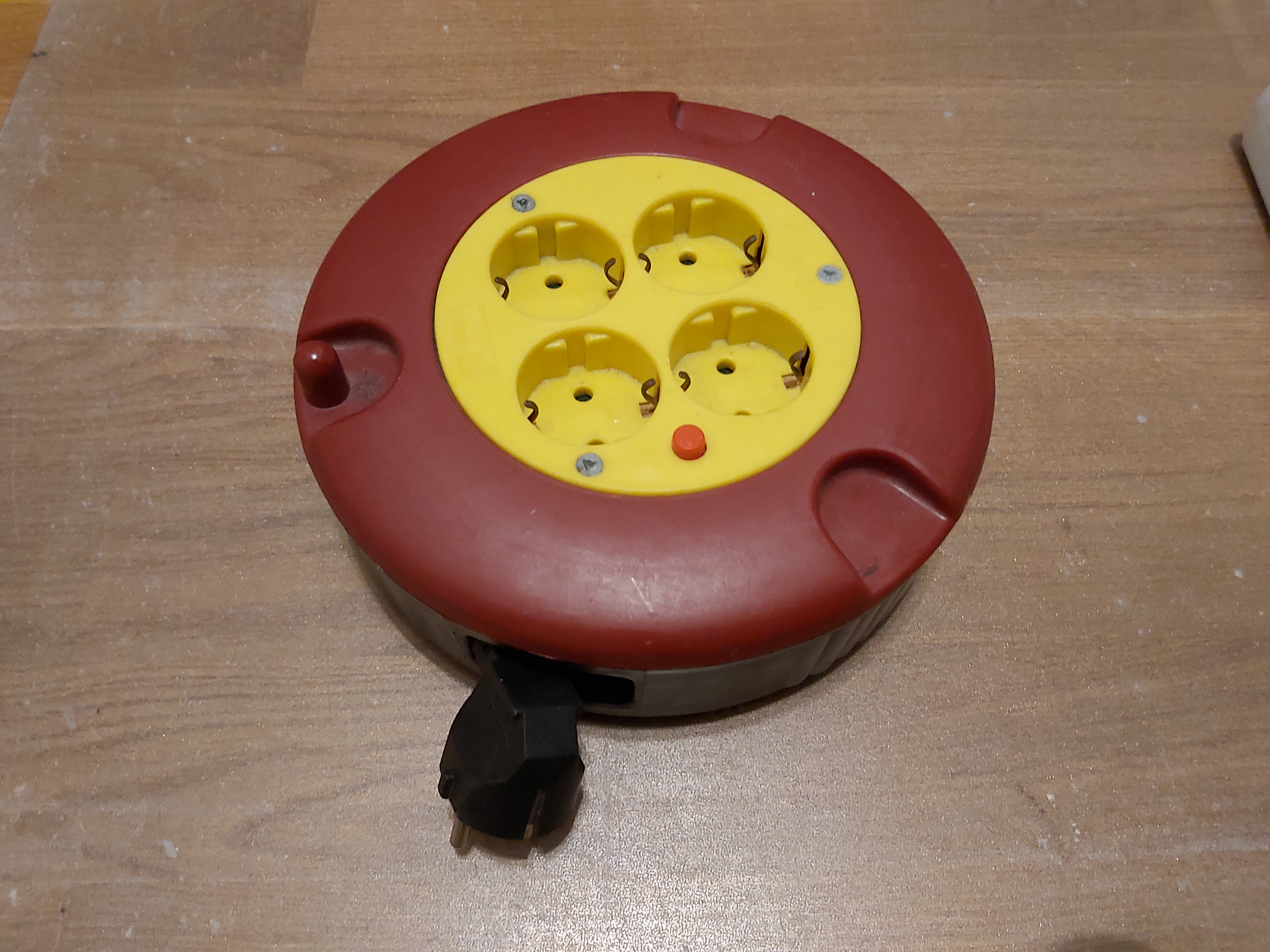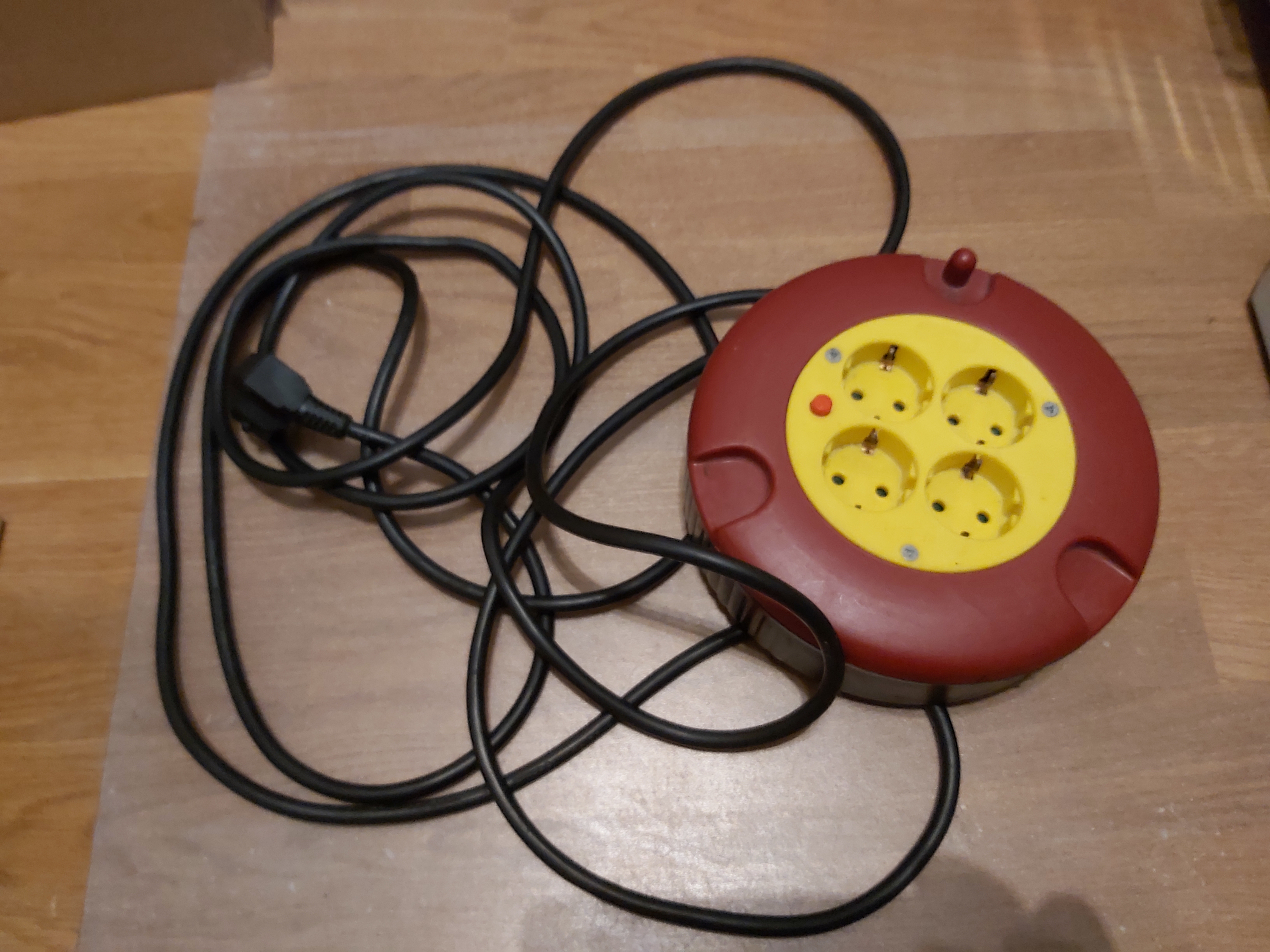What is the problem of using a coiled extension cord?
When the power cable passes a considerable load current, it will definitely heat up noticeably. As the load current increases, the temperature of the cable surface will be higher. A cable loaded near it’s rated current can feel that it is warm to the touch, but it should not be too hot to hold.
An extension cord that is in use while coiled up or coiled in a reel can be a fire hazard. The heat produced from the resistance cannot dissipate and is instead trapped between the tightly coiled cable as well as with cable on open air, which can lead to the a fire or shock hazard when cable is heavily loaded (can melt the wire insulation).
If the cable is not connected to anything (and no current is flowing through it) then its perfectly safe to coil them up and cable tie them out of the way. If there is considerable current in the wire then coiling it can potentially be an issue. The situation is such that a coiled cable can withstand much less current without overheating than an straight cable. If the straight cable can withstand 10A without heating considerably, when it is coiled up it can heat up considerably when loaded only few amperes. Typically 1.5 mm2 or 2.5 mm2 cable that can withstand 10A or 16A of current straight should not be loaded more than 3A on smaller coils (and even less with large coils). If you coil it up and use close to the maximum rating then it stands a good chance of melting the plastic insulation and then causing a short. You can find pictures of some melted coils at https://electronics.stackexchange.com/questions/192923/why-is-it-dangerous-use-a-coiled-extension-cord
Now if your extension cable had only been made of 1.5 mm^2 cable the resistance would be considerably higher and you would now be dissipating approx 3.4 Watts per metre, not far off double the heat to dissipate with even more disastrous results! Thicker cable = less voltage drop = less wattage consumed by the cable = less heat.
Another source says that A 25m extension cord with 2.5mm$^2$ conductors has about 0.165Ω resistance per conductor, or 0.33Ω total. When carrying 16A, the extension cord will dissipate about 85 Watts. 85 Watts in a small space with some insulating plastic around it is gonna get hot. So at high load with little cooling such a coiled cable could be a fire hazard. When in heavy use the cable will warm up and if this heat cannot dissipate it will eventually lead to the cable melting and fusing together, possibly even short circuiting and catching fire!
How hot can electrical cables get? The problem is the plastic insulation and jacketing that surround the wires. These are usually rated to withstand up to around 90 degrees Celsius (194°F), but temperatures that approach this limit are not recommended.
Cable reel extension leads should be preferably always fully unwound in use (to avoid coils overheating).
Some cable coils have built in over heating protector, but many don’t. With a coil hat has over heating protector, you might consider in some cases to use it to power light loads when coiled up (when you absolutely know that you will not be overloading coiled cable maximum current and the coil has overheating protection built in to stop if you did a mistake that overloaded the cable). So if you plan to power few smart phone chargers or a small radio, the heat generated will be of no concern, you can leave the cable rolled up. If you plan to connect hundreds of watts of light, heater, power tools or server computers, be sure to unwound the coil. The safest choice is that if you have excess cable you should ALWAYS unroll it and lay it out flat on the ground.
Does coiling a wire increase resistance?
The simple answer is no. Winding wire on a non-ferrous form will not change its resistance. Of course, it all depends on the details. If the wire is uninsulated, and the form is conductive (copper, silver, gold, platinum, etc) the form will short out the wire turns and reduce the total resistance.
Does coiling a wire increase cable inductance?
Inductance is the tendency of an electrical conductor to oppose a change in the electric current flowing through it. The flow of electric current creates a magnetic field around the conductor. You might have learned from physics class that essentially a wrapped up coil of metal with electrons running through it creates a linear magnetic field since moving electrons through a wire creates a redial field and if you approximate the coil to have infinite loops the field becomes liner. Nothing major happens with regard to magnetic fields with coiled extension cords since the cable hold a wire pair carrying equal and opposite current, thus creating two magnetic fields that almost completely cancel each other out.
There’s not much magnetic field involved. The current in in the neutral wire is equal and opposite to the live thus cancelling out any effect. It will pretty well cancel out the external magnetic field and the cable inductance. There is some small usually insignificant inductance and some magnetic field (usually not a problem unless near sensitive audio equipment).
When the power cable has live going in and neutral coming back near each other, those coils pretty well null out their coil effects pushing opposite direction. The inductance seen by mains power is pretty low.
Trust me. I have measured with 20 meter long and 8 meter long mains cable coil, and the inductance was not the thing to worry about. It was so low that it was hard to measure accurately with many meters.
I did measurement with 8 meters long coiled extension cord (3×1.5mm2 cable) and got inductance reading of around 1 microhenry when measured with one end shorted and measured from other end (inductance normal load sees). The maximum resolution of my meter was one microhenry, so the result is not very accurate. For comparison inductance of just one wire from one end to another was 20 microhenries when the wire was coiled in. For comparison the resistance of cable was less than one ohm (full loop including contact resistances on connectors).


6 Comments
Tomi Engdahl says:
How to Correctly Fig 8 Wind a Cable and it is not a Straight Figure 8
https://www.youtube.com/watch?v=jgq8-4m133o
It can desirable to wind a cable in a figure 8 to reduce inductance related heat in power cables, to fit a large cable in a case, or to reduce inductance related signal degradation in audio cables to name a few.
Turns out that winding a straight figure 8 is not optimal and does little to nothing in altering the inductance build up compared to a coiled cable. In this video you can hear the effects of inductance build up of coiled and Fig 8 cable as well as see it on an analyzer. I will also show you how to wind a cable figure 8 (perhaps better called a figure 80) such that there is little to no inductance build up.
Tomi Engdahl says:
Tomi Engdahl Good write up. Except one point about the 20W lightbulb – that energy density in W/m2 is a lot higher then the actual cable itself so the temp rise on tehinsulation is not much. And cable ratings in free air are usually fairly generous. Heating effects from regular coiling and or fig 8 coiling doesn’t matter much unless the whole cable is ennclosed /under a carpet etc etc.. PVC cable is the real risk as the cores start to migrate once the cable temp gets to about 60 to 70 deg C especially on tight bends. Rubber cable not so much. That is a real thing and have seen it happen.
asad says:
This website called http://www.signnow.com/esignature/electronic-signature-laws is a terrific platform. It is capable of performing my job better than any other platform. In addition, the rates are cheap!
asad says:
the amount of information that was there on the link was too enough for those who are not aware of intro of e-signature and its necessity. With the help of them i got to know create-and-automate-workflows people can sove their minor issues. This will save their time and ease their tension, I found it very helpful
asad says:
You know your projects stand out of the herd. There is something special about them. It seems to me all of them are really brilliant! ร้านกาแฟอุบล
Tomi Engdahl says:
Looping cable does not create extra resistance that causes wire heating to begin with. The small inductance added by coiling cable does not increase cable heating.
Tightly coiled cable just prevents the resistive heat from the cable to escape efficiently – cable heats up – heating up causes the copper wire resistance to increase slightly.